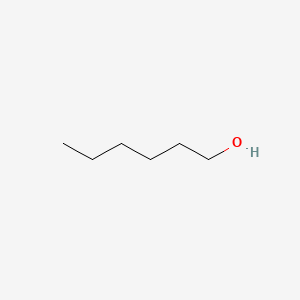

1. 1-hexanol, Aluminum Salt
2. 1-hexyl Alcohol
3. N-hexanol
1. Hexan-1-ol
2. Hexyl Alcohol
3. 111-27-3
4. Hexanol
5. N-hexanol
6. N-hexyl Alcohol
7. Amylcarbinol
8. 1-hydroxyhexane
9. 1-hexyl Alcohol
10. Caproyl Alcohol
11. Pentylcarbinol
12. Caproic Alcohol
13. N-hexan-1-ol
14. C6 Alcohol
15. Alcohol(c6)
16. Hexanol (van)
17. Fatty Alcohol(c6)
18. Epal 6
19. Hexyl Alcohol (natural)
20. Alcohol C-6
21. Fema No. 2567
22. Nsc 9254
23. Mfcd00002982
24. Hexanol-(1)
25. 6cp2qer8gs
26. 25917-35-5
27. Chebi:87393
28. Nsc-9254
29. Dsstox_cid_1931
30. Dsstox_rid_76410
31. Dsstox_gsid_21931
32. Caswell No. 482e
33. Hydroxyhexane
34. Hexanols
35. Fema Number 2567
36. Cas-111-27-3
37. He2
38. Hsdb 565
39. Einecs 203-852-3
40. Unii-6cp2qer8gs
41. Epa Pesticide Chemical Code 079047
42. Brn 0969167
43. Caproalcohol
44. Hexalcohol
45. Hexyl Alcohol, Active
46. N-hexylalcohol
47. Ai3-08157
48. N-hexenol
49. Nat.hexanol
50. Exxal 6
51. Einecs 247-346-0
52. Hexanol-cmpd
53. Exxal 6 (salt/mix)
54. Bdbm9
55. 1-hexanol, 98%
56. Hexyl Alcohol, Fcc, Fg
57. 1-hexanol [hsdb]
58. 1-hexanol [mi]
59. Ec 203-852-3
60. N-c6h13oh
61. Schembl1877
62. Hexyl Alcohol [fcc]
63. Natural Hexyl Alcohol
64. C6h13oh
65. Hexyl Alcohol [fhfi]
66. Hexyl Alcohol [inci]
67. Wln: Q6
68. 4-01-00-01694 (beilstein Handbook Reference)
69. Mls001055374
70. Un 2282 (salt/mix)
71. Bidd:er0298
72. Chembl14085
73. 1-hexanol, Analytical Standard
74. Dtxsid8021931
75. 1-hexanol, Anhydrous, >=99%
76. Nsc9254
77. 1-hexanol, Reagent Grade, 98%
78. Dtxsid001022586
79. Hms3039l08
80. Bcp29486
81. Zinc1699882
82. Tox21_201335
83. Tox21_302953
84. Lmfa05000117
85. Stl282713
86. Un2282
87. Akos009031422
88. 1-hexanol 100 Microg/ml In Methanol
89. Hy-w032022
90. Alcohol C-6, Natural, Natural Hexanol
91. 1-hexanol, Purum, >=98.0% (gc)
92. 1-hexyl Alcohol Pound>>1-hexylalcohol
93. Ncgc00090949-01
94. Ncgc00090949-02
95. Ncgc00256385-01
96. Ncgc00258887-01
97. Hexanols [un2282] [flammable Liquid]
98. Ls-13216
99. Smr000677945
100. 1-hexanol, Saj Special Grade, >=99.0%
101. 1-hexanol, Vetec(tm) Reagent Grade, 98%
102. Cs-0076046
103. Ft-0607887
104. H0130
105. Hexyl Alcohol, Natural, >=98%, Fcc, Fg
106. En300-19338
107. Q76933
108. 1-hexanol, Reagentplus(r), >=99.5% (gc)
109. J-002549
110. F0001-0237
111. Z955123546
| Molecular Weight | 102.17 g/mol |
|---|---|
| Molecular Formula | C6H14O |
| XLogP3 | 2 |
| Hydrogen Bond Donor Count | 1 |
| Hydrogen Bond Acceptor Count | 1 |
| Rotatable Bond Count | 4 |
| Exact Mass | 102.104465066 g/mol |
| Monoisotopic Mass | 102.104465066 g/mol |
| Topological Polar Surface Area | 20.2 Ų |
| Heavy Atom Count | 7 |
| Formal Charge | 0 |
| Complexity | 27.4 |
| Isotope Atom Count | 0 |
| Defined Atom Stereocenter Count | 0 |
| Undefined Atom Stereocenter Count | 0 |
| Defined Bond Stereocenter Count | 0 |
| Undefined Bond Stereocenter Count | 0 |
| Covalently Bonded Unit Count | 1 |
Mesh Heading: Anesthetics, Nicotinic antagonists
National Library of Medicine, SIS; ChemIDplus Record for 1-hexanol (111-27-3). Available from, as of April 13, 2006: https://chem.sis.nlm.nih.gov/chemidplus/chemidlite.jsp
Anesthetics
Agents capable of inducing a total or partial loss of sensation, especially tactile sensation and pain. They may act to induce general ANESTHESIA, in which an unconscious state is achieved, or may act locally to induce numbness or lack of sensation at a targeted site. (See all compounds classified as Anesthetics.)
Nicotinic Antagonists
Drugs that bind to nicotinic cholinergic receptors (RECEPTORS, NICOTINIC) and block the actions of acetylcholine or cholinergic agonists. Nicotinic antagonists block synaptic transmission at autonomic ganglia, the skeletal neuromuscular junction, and at central nervous system nicotinic synapses. (See all compounds classified as Nicotinic Antagonists.)
The permeability of excised rat skin to 1-hexanol was increased by hydration for the first ten hours, then returned to baseline.
Snyder, R. (ed.). Ethel Browning's Toxicity and Metabolism of Industrial Solvents. Second Edition. Volume 3 Alcohols and Esters. New York, NY: Elsevier, 1992., p. 179
The in vitro dermal flux in human skin (epidermis) was reported to be 0.044 mg/sq cm/hr, indicating a low rate of dermal uptake.
Bingham, E.; Cohrssen, B.; Powell, C.H.; Patty's Toxicology Volumes 1-9 5th ed. John Wiley & Sons. New York, N.Y. (2001)., p. 6:441
Through successive oxidation processes, 1-hexanol is converted to hexanoic acid, which then undergoes beta-oxidation.
Snyder, R. (ed.). Ethel Browning's Toxicity and Metabolism of Industrial Solvents. Second Edition. Volume 3 Alcohols and Esters. New York, NY: Elsevier, 1992., p. 179
1-Hexanol has a high affinity for ADH /alcohol dehydrogenase/, similar to amyl and n-octyl alcohol, and is a potent inhibitor of ethanol oxidation. 1-Hexanol is metabolized by direct conjugation with glucuronic acid and by oxidation to the carboxylic acid and eventually to carbon dioxide.
Clayton, G. D. and F. E. Clayton (eds.). Patty's Industrial Hygiene and Toxicology: Volume 2A, 2B, 2C: Toxicology. 3rd ed. New York: John Wiley Sons, 1981-1982., p. 4610
Metabolic studies in rabbits indicate that oxidation to hexanoic acid is the major pathway, mediated by alcohol dehydrogenase and aldehyde dehydrogenase. Direct conjugation with glucuronic acid is a minor pathway.
Bingham, E.; Cohrssen, B.; Powell, C.H.; Patty's Toxicology Volumes 1-9 5th ed. John Wiley & Sons. New York, N.Y. (2001)., p. 6:440
... Ethanol and 1-hexanol were found to have two competing concentration-dependent effects on the Ca(2+)- and phorbol ester- or diacylglycerol-dependent activities of PKCalpha associated with either RhoA or Cdc42, consisting of a potentiation at low alcohol levels and an attenuation of activity at higher levels. Measurements of the Ca(2+), phorbol ester, and diacylglycerol concentration-response curves for Cdc42-induced activation indicated that the activating effect corresponded to a shift in the midpoints of each of the curves to lower activator concentrations, while the attenuating effect corresponded to a decrease in the level of activity induced by maximal activator levels. The presence of ethanol enhanced the interaction of PKCalpha with Cdc42 within a concentration range corresponding to the potentiating effect, whereas the level of binding was unaffected by higher ethanol levels that were found to attenuate activity.
PMID:14556642 Slater SJ et al; Biochemistry 42(41):12105-14 (2003)